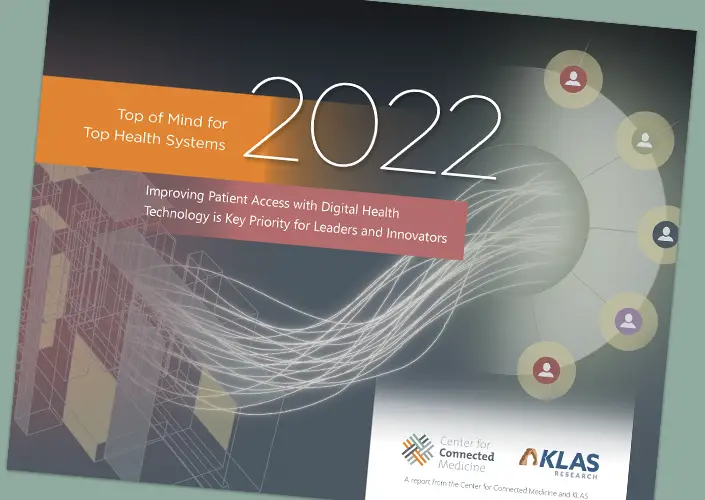
What You Should Know:
– Improving patient access to medical services is a top priority for health system leaders in 2022, according to new research from the Center for Connected Medicine (CCM) and KLAS Research.
– According to new research, patient access was identified by health system leaders as the challenge in healthcare that can be best addressed with telehealth in the coming year.
Nearly 99% of health systems identified improving patient access as a “high” or “very high” priority for their health system, according to a new research report from Center for Connected Medicine (CCM) and KLAS Research. The report finds more than 85% indicated their health system is likely to invest in patient access technology,
Report Background
The CCM’s “Top of Mind for Top Health Systems 2022” research report examines patient access solutions and strategies being considered and deployed at health systems to deliver a more consumer-friendly approach to care. Conducted in partnership with KLAS Research, the CCM’s Top of Mind research included interviews with 72 leaders from 67 health systems across the United States. The respondents included C-suite level executives, vice presidents and directors, mostly in clinical information technology, digital strategy and business roles.
Defining Patient Access
The Top of Mind research defines patient access as technology that helps patients access and receive health care in an effective, convenient and secure way — both for facilitating in-person and virtual care — and include solutions such as self-scheduling, telehealth, remote patient monitoring, bill-pay and price transparency tools.
Key Findings
The report is being released as the COVID-19 pandemic continues to not only spur innovation at health systems, but also impede traditional approaches to care delivery. Research respondents identified the need for more efficient use of resources and growing consumer demands as the leading reasons for pursuing patient access technology.
Key findings from the report include:
– Telehealth services and patient reminders were cited as the most utilized technology to improve patient access, followed by an online provider directory, online bill-pay and self-scheduling tools.
– Patient financial experience vendors are seen as valuable but aren’t widely used; only 17% of respondents said their organization was using such a vendor.
– Nearly two-thirds (64%) of respondents agreed that greater price transparency can improve patient access. But to be valuable for patients, these efforts need to provide better visibility of patients’ out-of-pocket costs.
Fraud Schemes in a Telehealth Era: What Healthcare Payers Should Know
What You Should Know:
– Report from Codoxo that finds 10-15% of telehealth claims fall outside of approved CMS codes and indicates a high potential for rapidly increasing fraud schemes (and provider coding errors) in a new telehealth era.
Codoxo, a provider of healthcare artificial intelligence solutions for healthcare payers and agencies, today released a new study revealing that among the 41% of provider specialties showing statistically significant increases for telehealth adoption, up to 15 percent of telehealth claims are non-compliant with CMS guidelines.
Report Background
The report, “Fraud Schemes in a Telehealth Era: What Healthcare Payers Should Know,” highlights provider specialties where telehealth modifiers were used but lack accompanying eligible CMS billing codes, which may indicate wasteful, abusive or erroneous practices and warrant immediate investigation. Codoxo’s study was conducted over claims submitted across various geographic regions from September 2019 to July 2021.
Within the first three weeks of the WHO declaring the COVID-19 pandemic, telehealth visits skyrocketed 154 percent, according to the Centers for Disease Control and Prevention, compared to the same time period just one year prior. After sharply peaking in April 2020, telehealth has since leveled off, finding a new elevated steady state at approximately 20-times higher than pre-COVID rates, according to Codoxo’s anonymized health plan data.
Telehealth Spend
Starting in May 2021, the percentage of spend on telehealth appears to stabilize at 4.5%, a level approximately 20 times higher compared to the pre-COVID era. The new baseline appears non-reactive to the emergence of new COVID-19 cases.
Top 20 Provider Specialties Adopting Telehealth
1. Physician/Psychiatry
2. Licensed Clinical Social Worker
3. Hospital-Psychiatric Unit
4. Psychologist, Clinical
5. Physician/Physical Medicine & Rehabilitation
6. Physician/Neuropsychiatry
7. Physician/Addiction Medicine
8. Physician/Endocrinology
9. Certified Clinical Nurse Specialist
10. Physician/Family Practice
11. Physician/Geriatric Psychiatry
12. Physician/Geriatric Medicine
13. Physician/Emergency Medicine
14. Physician/Hospice and Palliative Care
15. Physician Assistant
16. Nurse Practitioner
17. Physician/Internal Medicine
18. Physician/Sleep Medicine
19. Registered Dietitian or Nutrition Professional
20. Physician/Medical Toxicology
“Any time we see significant changes in the healthcare industry and radical shifts in billing patterns, bad actors find a way to take advantage of those transitions. The boom in telehealth was no exception,” stated Musheer Ahmed, Codoxo’s Founder and Chief Executive Officer. “But if healthcare payers and government agencies can quickly identify, investigate, stop, and prevent suspicious telehealth activity and incorrect payments, the entire healthcare ecosystem benefits by avoiding massive, unnecessary, and otherwise avoidable costs.”
For more information, download the full report here.
